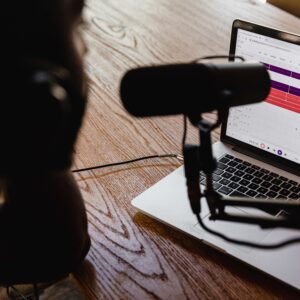Remote podcast recordings are here to stay. With a few simple steps, you can make your audio sound its best, even from afar.
Remote podcast interviews have increased in popularity and necessity during the pandemic.
Working from home, many podcasters have adapted to the pros and cons of conducting interviews remotely.
Having your guests record from home affords you more flexibility in scheduling, safety during the pandemic, and the ability to record with guests from long distances.
When you record a podcast remotely, however, there can be a few disadvantages, including reduced audio quality, technical difficulties or lack of social connection with your guests.
Fortunately, you can manage these problems with practice and intentionality. Follow these pieces of advice and best practices to ensure your remote recording goes as smoothly as possible.
Help your guest build a great recording environment
The most important factor in getting good audio during a remote interview is your guest’s recording environment. Their surroundings and setup matters even more than their recording equipment. A cheaper mic in a good environment sounds better than an expensive mic in a bad environment.
To get the best audio for your podcast, give your guests some advice on how to improve their recording environment. They should record in an area with soft surfaces, like a closet full of clothes, a wall of pillows, or even under a blanket.
It’s also important that your guest is mindful of any potential background noise that could disrupt the recording. Make sure guests put their pets in another room, warn their roommates they’re recording, and remember to turn their phones on “‘Do Not Disturb”’ mode.
Additionally, you’ll want to make sure guests are recording somewhere with a good internet connection.
Make sure your guest uses the right recording equipment
While the recording equipment isn’t as important as the recording environment, it still matters. Most guests are unlikely to have their own professional microphone that they can use to record.
Instead, we recommend guests connect to the interview using wired headphones that have a microphone built in. Tell your guests to avoid wireless headphones, because they compress the sound too much.
Additionally, headphones keep sound from coming from your guest’s computer speakers. Without headphones, the microphone they’re using can pick up sound from those speakers, which can greatly decrease the audio quality and make editing more difficult. By having your guest wear headphones, you can easily avoid this issue.
Keep the remote podcast recording process as simple as possible
When you record a podcast remotely, the last thing you want is for a guest to be stressed about technology and unable to focus on the interview at hand. Try to keep things as simple and low stakes as possible to avoid this problem.
Ideally, you want the guest to click on the link to the recording session and to avoid a lot of troubleshooting, so it’s important to communicate advice about recordings and equipment well before the interview takes place.
Send your guest a checklist or a simple preparation guide, like this one:
- Find a quiet spot
- Check your internet connection
- Bring wired headphones
- Silence your cell phone
- Activate “Do Not Disturb” on your cell phone
Additionally, you should reassure your guest that you’re happy to help them with anything they need in preparation for the interview.
By following these tips when you record a podcast remotely, your interviews will sound better and feel less stressful. Just remember to communicate to your guests that their recording environment and equipment are the keys in making them sound their best.
For more content like this, subscribe to our newsletter, Brandcasting. Ready to build your own branded podcast? Let us help you get started with a free consultation.
